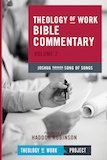Introduction to Ezra, Nehemiah & Esther
Bible Commentary / Produced by TOW Project
Most Christians don’t find their workplaces very supportive of their faith. Generally, there is limited scope for explicitly Christian witness and action. Moreover, workers may feel pressure to violate the ethical requirements of biblical standards, either explicitly or implicitly. In a pluralistic society, some such limits may be appropriate, but they can make the workplace feel like alien territory to Christians. The books of Ezra, Nehemiah and Esther depict what it is like for God’s people to work in unwelcoming workplaces. They show God’s people working in jobs ranging from construction to politics to entertainment, always in the midst of environments openly hostile to God’s values and plans. Yet along the way they receive surprising help from nonbelievers in the highest positions of civic power. God’s power seems to crop up for his people’s good in surprising places, yet they face extremely challenging situations and decisions, upon which they don’t always agree.
Ezra had to ponder whether to trust an unbelieving ruler to protect the Jewish people as they returned to Jerusalem and began rebuilding the temple. He had to find financial support within the corrupt economic system of the Persian Empire, yet to be true to God’s laws about economic integrity. Nehemiah had to rebuild the walls of Jerusalem, which required him to both trust God and be pragmatic. He had to lead people whose motivation ranged from altruism to greed, and get them to overcome their divergent self-interests to work towards a common purpose. Esther had to survive both the oppression of women and the deadly intrigue within the Persian royal court, yet remain ready to risk everything to save her people from genocide. Our titles and institutions have changed since their days, but in many ways our workplaces today have much in common, for better or worse, with the places where Ezra, Nehemiah and Esther labored. The real life situations, challenges and choices found in these biblical books help us develop a theology of work that matters in how we live each day.
Ezra and Nehemiah
In 587 BC, the Babylonians, under the rule of King Nebuchadnezzar, conquered Jerusalem. They killed the leaders of Judah, plundered the temple before burning it to the ground, destroyed much of the city, including its walls, and took the cream of Jerusalem’s crop of citizens to Babylon. There, these Jews lived for decades in exile, always hoping for God’s deliverance and the restoration of Israel. Their hopes were heightened in 539 BC when Persia, led by King Cyrus, overthrew Babylon. Shortly thereafter, Cyrus issued a decree inviting the Jews in his kingdom to return to Jerusalem and rebuild the temple and, therefore, their life as God’s people (Ezra 1:1-4).
The books of Ezra and Nehemiah, originally two parts of a single work,[1] narrate crucial aspects of this rebuilding story, beginning with the edict of Cyrus in 539 BC. Their purpose, however, is not simply to describe what happened long ago out of antiquarian curiosity. Rather, Ezra and Nehemiah use historical events to illustrate the theme of restoration. These books show how God once restored his people and how people played a central role in this work of renewal. Ezra and Nehemiah were written by an unknown author, probably in the fourth-century BC,[2] to encourage the Jewish people to live faithfully even under foreign rule, so that they might be participants in God’s present and future work of restoration.
Ezra and Nehemiah are highly theological books, but they do not directly address the theology of work. They do not include legal imperatives or prophetic visions having to do with our daily labors. The narratives of Ezra and Nehemiah do describe arduous work, however, implicitly placing work in a theological framework. Thus we’ll find beneath the surface of these books rich soil from which a theology of work might sprout. In particular, Ezra and Nehemiah were called to restore God’s kingdom (Israel), in the midst of a partially-hostile, partially-supportive environment. Today’s workplaces are also partially hostile and partially supportive of the work of God. This encourages us to work out how our work may contribute to implanting God’s kingdom in today’s world.
Esther
The Book of Esther tells the story of one curious episode during the era depicted in Ezra and Nehemiah. It focuses, not on the restoration of Jerusalem, but rather on events happening in Persia when Ahasuerus, better known to us by his Greek name, Xerxes, was king (485-465 BC). The narrative of Esther accounts for the origins of the Jewish festival of Purim. The unidentified author of this book wrote, in part, to explain and encourage celebration of this national holiday (see Esther 9:20-28).[3] His broader concern was to examine how Jews could survive and even thrive as exiles in a pagan and often hostile land.[4]
In contrast to Ezra and Nehemiah, Esther is not explicitly theological at all. In fact, God is never mentioned. Yet no faithful reader could fail to see the hand of God behind the events of the book. This invites the reader to ponder how God may be at work in the world unnoticed by those without eyes to see.









